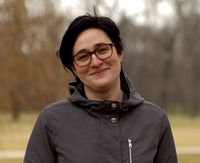|
|
|||
Interview with Viera Čákanyová

Viera Čákanyová (1980) is a documentary film director and scriptwriter. Her shortand medium-length films won numerous international awards including ones at Visions du réel 2010 and Kasseler 2010 (both for film Alda, 2009). FREM is her first feature film.
Your film is about an artificial intelligence breaking into the physical world and coming to know it. How did you come up with the idea?
- For a long time, I have been following the progress in AI and other technologies we are developing in an effort to overcome the evolutionary biological limits of our species. The evolution of AI can be pretty unpredictable which is stimulating artist’s imagination. In my film, the main character is not a human being, but a new form of a non-human entity observing the natural world we are part of. I think we are living in times when we need to address our position in the world from a planetary perspective instead of using our usual anthropocentric perspective and that involves a certain distance from ourselves. Maybe it’s also a question of our survival on this planet we are systematically and successfully destroying.
Your film suggests the presence of AI as an independent agent, yet it seems to be without a “physical body” – we only get to know it through its “sight”. Why did you choose this approach?
- When watching the film, I wanted to suggest the feeling of being inside the head of this entity. AI’s “mental processes” are spatially distributed using the 5.1 sound architecture, which also supports this idea. As to the visual, we decided to use a subjective camera, which hopefully helps the audience to identify with the “main character”, even if it refers to a non-human experience. However, the aspect of a body and physicality is present in the film, at least in the form of a shadow on the snow. At one point, it becomes evident that what we are following is not just an abstract consciousness. As suggested in the prologue, the entity uses a sort of “physical prosthesis” to step out of its natural digital environment to explore the organic one.
You mentioned POV shots and identification with the “main character”, but how can we identify or even empathize with a non-human entity?
- Humans have a natural urge to anthropomorphize all sorts of agents, which certainly helps with the “identification problem”, but in this specific case can lead to quite tricky results. How can we think of something which is non-human in its nature? To be even capable of this thought, we would need to step outside of our (human) brains and use some kind of meta-brain. That was also why the whole process of creating this film was a constant challenge to everyone's imagination.
Why did you choose to shoot in Antarctica? Its environment evokes pre-human or post-human times...
- That was exactly the reason! Even though talking about the pre- or post-human era in the context of geological time is irrelevant – the human era is absurdly short. Nature and matter were here long before us and will remain here long after we are gone. In Antarctica, you are very well aware of this simple fact. The landscape around you is mostly inorganic, monumental, beautiful and indifferent at the same time. It offers itself to be observed and reflected upon by human consciousness in its short moment of existence.
Was your intention to use the vast landscapes of Antarctica and its post-apocalyptic feel to hint the problem of climate change? Moreover, both, AI and climate change are among the greatest threats to human species, they are both getting (or, quite probably, soon will be getting) out of our control. Do you think there is a connection between the two?
- We got used to the idea that scientific and technological inventions will help us deal with the increasingly complex problems that we create. And climate change is an extremely complex problem. To be able to evaluate connections among millions of different inputs and outputs, influences and micro-influences, we collect huge amounts of data and we use various forms of AI that help us make sense out of them. It’s only one of the AI’s applications in areas where our mental capacities are inferior. At the same time, we are creating artificial neural networks based on evolutionary biological mechanisms that are able to learn and improve themselves. No-one can predict where exactly this silicon evolution will lead. There is a reasonable concern presented by part of the scientific community, that as soon as AI exceeds our level of intelligence, we lose control over it. At the same time, we are working very hard on our self-destruction by accelerating the climate change. Today it’s clear that its impact is unavoidable; the question is only how fatal for (not only our) biological species it will be. And here comes the idea which initiated FREM – the emergence of a new, post-human observer, a possible witness of our extinction.
Related AIC articles:
After world premiere at Ji.hlava IDFF, Viera Čákanyová's feature debut FREM (2019) will be also presented to Berlinale's audience.
published: 12.02.2020
updated: 12.02.2020




